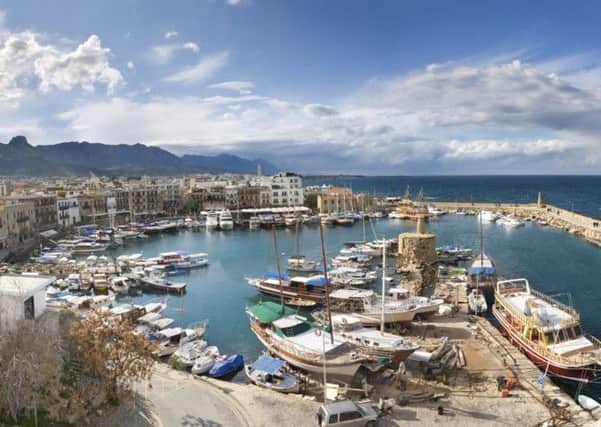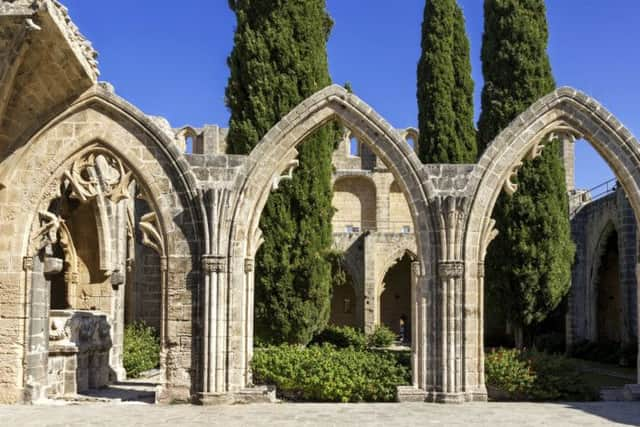Travel: Turkish delight in Northern Cyprus


THERE are many ways of gaining insights into the delights and dilemmas of what is known as the Turkish Republic of Northern Cyprus. Mine came in a strategically placed restaurant overlooking the town of Kaplica in the Karpas Peninsula, the “panhandle”of Cyprus.
We called in at a family establishment for a quick midday snack. Some hope. The idea is not familiar anywhere in the Mediterranean. A request for one lamb dish and one small kebab was greeted with polite surprise, and ignored, as the table was filled with preliminary dishes of olives, baba ganoush, tzatziki, taramosalata, a salad that elsewhere would be called “Greek”, pieces of melon, various breads and oil.
Advertisement
Hide AdThe view over the town, shimmering in high temperatures even in October, took in the houses placed on a gentle slope with the mosque and Orthodox church side by side, but not in friendly proximity. The mosque is a thriving centre of worship but the church is closed, neglected and crumbling, as it has been since 1974, when the island was divided into a Turkish north and a Greek south. This is a divided society, and the two communities inhabit totally separate sides of the island. On one side, mosques are shuttered, on the other the churches.


Tourism is picking up on the Turkish side, although not on the scale of the south. The atmosphere is welcoming, the people friendly, the style of life and dress as relaxed as in any other part of Europe. The Islamic regulations on women’s clothing or restrictions on the availability of alcohol do not apply. The roads, built with cash from Turkey are excellent. For better or worse, the once isolated province of Karpas is opening up. Wild donkeys roam on the hills, turtles lay their eggs on some beaches, and the hotel industry is expanding alongside some quite spectacular stretches of sand. It is a great area for hiking and hill walking, or so I am reliably informed.
At the northern tip of the peninsula, and the whole island, stands the monastery of St Andrew the Apostle, built at the point where the apostle landed to find water for the ship he was sailing on. There was none on hand, but being a saint in the making, he struck a rock and water flowed. It still does, and has curative qualities. The monastery is currently closed for restoration, but roads are being built around it and residential quarters expanded in the expectation of bus loads of visitors.
A drive from there along the southern coast of the peninsula is exhilarating, and leads to the town of Famagusta, or Gazimagusa in Turkish. Before partition, this was Cyprus’s main resort, but at its centre stands one of Europe’s saddest sites, the area of Varosha, once the home of the Greek community but now totally deserted and enclosed by barbed wire through which decaying houses, hotels, schools and churches can be glimpsed.
Gazimagusa is a fascinating city, surrounded by the walls the Venetians built when they were masters. At one curve, there stands the building known as Othello’s Tower, a name given by the British when the island was a colony. The magnificent Gothic cathedral, constructed by French lords during their rule, was made into a mosque by the Turks when they were in command. History lives in Cyprus. Both the ancient Greeks and Romans settled in the island, and the beautiful ruins of Salamis, which have been extensively excavated to reveal theatres, houses and temples, are not far off. Gazimagusa has not lost the tourist attractiveness of earlier days, and there are some modern villages with chic bars and restaurants on the coast around the city. Hotels seem happy to allow visitors access to “their” beaches in return for the purchase of a drink or a meal.
Over on the north coast, Kyrenia, or Girne in Turkish, remains the prime destination for visitors to northern Cyprus. Many will be drawn there after reading Bitter Lemons, Lawrence Durrell’s engrossing memoir of his own Cypriot days. Durrell bought a house in the nearby village of Bellapais, whose name derives from the Catholic monastery in the village centre, now one of the most romantic ruins imaginable. The refectory is also used for concerts. We heard a recital of opera and sacred music there, and it is hard to think of any environment that more deeply enhances an artistic experience.
Advertisement
Hide AdGirne is a port city, so families looking for sea and sand would be advised to move along the coast. The city has expanded enormously since Durrell’s days, but the old centre, with its narrow streets, quiet lanes, palaces transformed into hotels and churches converted to galleries retains its identity and charm. The harbour, with the Venetian castle above it, bobs with the yachts of the wealthy and tourist excursion boats, while the streets bordering it are lined with outdoor restaurants.
From Girne, it is worthwhile making a trip to at least one of the three crusader castles, relics of another epoch of a varied history, which stand in the mountains behind the city. Buffavento is the most striking.
Advertisement
Hide AdThe approach is up a terrifying mountain road, with a sheer drop down a ravine on one side, and from the car park the pilgrim still faces a long, sweaty climb up a winding staircase. How the crusaders and their horses could have managed is beyond understanding, but the reward today is the haunting experience of the castle and a view out over the mountains that will fire the most sluggish imagination.
The holiday-maker will find an unpolluted sea, attractive beaches and good cuisine, but Cyprus was inhabited by many civilisations, and the more adventurous will find fascinating traces of their presence in out of the way corners.
• Since the Turkish republic of Northern Cyprus is recognised only by Turkey, there are no direct flights from any other European country. The choice is either to fly via Turkey or to fly to southern Cyprus and take a taxi over the border post in Nicosia (Lefkosa). A Glasgow to Larnaca return with Thomas Cook Airlines costs around £220, with the taxi ride extra but inexpensive. Return flights with Pegasus Airlines from Stansted to Lefkosa via Izmir (Turkey) start at about £160.